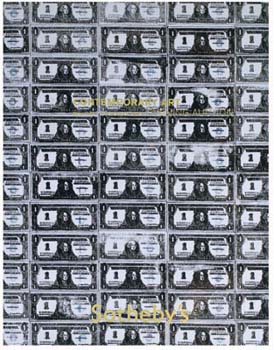Sotheby's Contemporary Art Evening Auction
New York 11 Novemeber 2009- 2009
- Related to Andy Warhol (American 1928-1987)
- Printed auction catalogue
27.0 x 21.0 x 1.0 cm., 10-5/8 x 8-1/4 x 1/2"
- Catherine Carter Goebel, Paul A. Anderson Chair in the Arts Purchase through Gift of Paul and Marty Pearson, Paul A. Anderson Art History Collection, Augustana College 2010.47.a, b

Essay by Lendol Calder, Professor of History
When Andy Warhol's 200 One Dollar Bills came up for auction at Sotheby's in November 2009, the painting sold for $43.8 million. If you wonder what is going on here, you are asking the signature question of art criticism.
The story goes that when an art dealer advised Warhol to paint what he liked best, the answer was, "Money." Warhol wasn't crass, just honest. The average person expends $2.2 million in a lifetime. That's a lot of bills. But you can look at something every day and never see it. Case in point: can you name the creature peeking out from the "1" in the upper-right corner of a dollar bill? (Hint: look closely.) In art as in life, seeing is the first step to understanding.
200 One Dollar Bills was one in a series of "Dollar Bill" paintings Warhol created in March/April 1962. Some featured single bills; others displayed group formats like the Campbell's Soup Can paintings completed earlier that year. New with this series was Warhol's use of a silkscreening process which made the serial images more exactly the same, thereby suggesting the fabulous plenitude of American consumer society but also themes of uniformity, monotony, and impersonality.
When 200 One Dollar Bills was first exhibited, people wondered, "Is this art?" A more difficult question follows: what is money?
Try this: take a dollar bill and tear it in half. If you are like most people you'll have trouble bringing yourself to do this. A dollar is just rag paper, yet somehow it resists annihilation. Knowing what money is made of does not get at what money is.
Deeply religious, Warhol attended Catholic mass nearly every day. In church he heard Jesus warn that Mammon is a jealous god demanding complete allegiance. That money has a demonic power makes sense to people, on Sundays. Other days of the week, Americans have favored the more pragmatic view that money is a swell friend indeed.
Mostly, people take money for granted. Warhol's 200 One Dollar Bills reminds us that the existential questions surrounding money are ever with us, if we will but look at money to see it for what it is.
